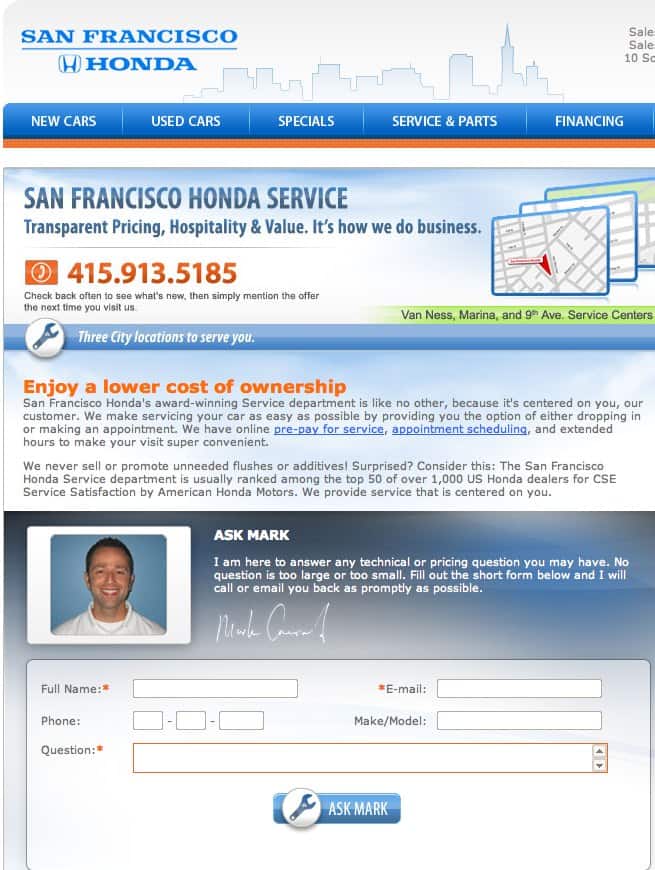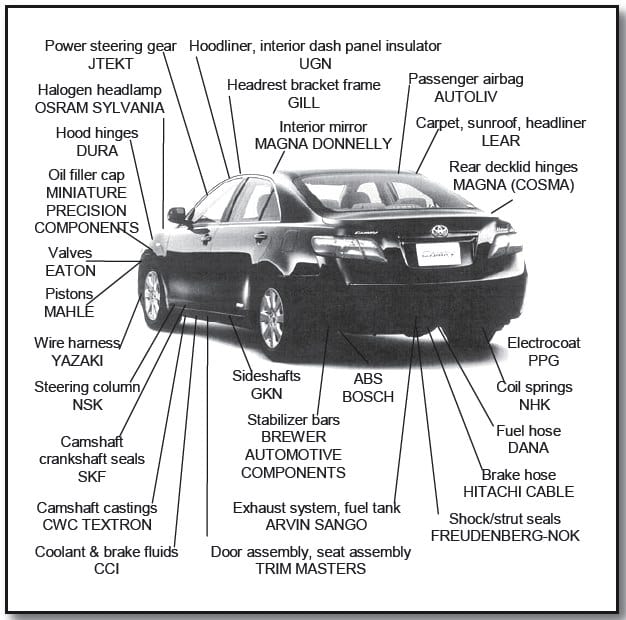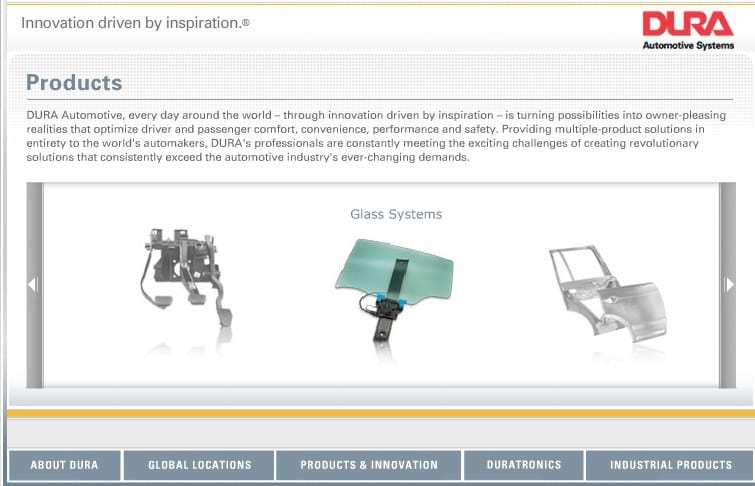How to Understand Why Auto Parts Distribution is So Inefficient
Executive Summary
- How the aftermarket car parts market in the US works.
- The major problems with automotive dealer networks for aftermarket car parts.
Introduction
In our previous post, we discussed the problems with how dealers dominate automotive service parts websites. We also explained how this is inefficient and why these websites should be centralized and either managed by the manufacturer or outsourced to a company with this as a focus.
However, after further research, it turns out automotive service networks have even bigger problems than this. This quote is from the HBR article called Winning in the Aftermarket:
Some years ago, when we studied the after sales network of one of America’s biggest automobile manufacturers, we found little coordination between the company’s spare parts warehouses and its dealers. Roughly 50% of consumers with problems faced unnecessary delays in getting vehicles repaired because dealers didn’t have the right parts to fix them. Although original equipment manufacturers carry, on average 10% of annual sales as spares, most don’t get the best out of those assets. People and facilities are often idle, inventory turns of just one to two times annually are common and a whopping 23% of parts become obsolete every year. – HBR
Improper Parts Planning
When consultants for aftermarket car parts planning software company MCA Solutions go into an account and uses its SPO software to perform inventory re-balancing, they often find that parts are kept too low in the supply network (i.e., at the dealers). This is usually because fill rates are only being locally managed, and local managers attempt to move parts to where they will eventually be consumed. The problem with this is that transferring parts from a forward location to another forward site is less efficient than moving parts from the parts depot to the forward location. Secondly, there is no reason to move apart to a forward location unless there is a high probability of consumption unless transportation lead times are particularly long.
This analysis of where parts of the field should be located goes by some names, including multi-echelon inventory optimization, re-distribution, and inventory re-balancing.
The independent dealer model continues to work against rational inventory pooling. AMR Research (now part of Gartner) does have a good point when they bring up this point in their paper Service Parts Planning and Optimization.
During the course of this research, we found SPP applications tended to be very tactical nature, solving specific inventory, fill rate, or service-level goals. Oftentimes service is still being viewed as a cost center, and SPP applications are not necessarily viewed as the keys to a greater world of service nirvana. One explanation is that the buyers of SPP software tend to be planning managers or director-level planners who have no jurisdiction over service and repair or other areas of the SLM model. Other reasons include outsourcing, where OEMs have outsourced the service process but retain the planning aspects, or the fact that the company was never in charge of service in the first place—think of an auto OEM and the dealers that actually provide the service. – AMR Research
Better Aftermarket Car Parts Planning Begins with Cooperative Planning
Rather than having every dealer attempt to manage its inventory, a much more rational and effective setup is for the dealers to pool their parts at a local depot and for the depot to handle the parts for them. Daily local “milk runs” would ensure part flow to the dealers and reduce the poor inventory turn off the dealers’ parts.
A series of these depots can then be large enough to be electronically connected. And to have their inventory represented in a web order fulfillment system that can better match supply and demand than a series of disconnected dealers all trying to manage a smaller amount of inventory locally. Honda (for instance) could manage this themselves, or instead, could outsource the management to a company like Amazon.com, that knows how to produce transactional websites and knows how to match supply and demand. This solution would be vastly superior to the current one where small dealers attempt to manage their aftermarket car parts websites (and where it took us 2 hours searching various dealer sites to find that we would have to call in to order a part).

What is happening in the dealerships is a disinterest in making changes or becoming more flexible to adopt new technologies. Companies can make a lot of money in the short-term by simply living off of monopoly power. GM was the poster child for inept management, inward thinking, abusive supplier relations, and unresponsiveness to customers. A good catchphrase for management consultants could be “Don’t be Like GM.” While Honda’s quality is better than GM’s ever was, Honda’s dealer network on their aftermarket car parts management is not all that much different or better. Most manufacturers seem to employ the same inefficient system, which gets little coverage from media outlets. This demonstrates the restrictive influence of the dealership system that no matter how good the car company, the dealer system remains anachronistic.
It often seems that the large American car companies have little interest in their service operations. Instead, they prefer to spend their money on advertising. They have lost the aftermarket battle, which reflects in their new sales, although they are unable to make the connection.
To quote again from the HBR article Winning in the Aftermarket:
In the automobile industry, for example, there’s a distinct correlation between the quality of after sales service and customer intent to repurchase. Brands like Lexus and Saturn inspire repeat purchases by providing superior service, and, consequently, they have overtaken well established rivals like Ford and Chrysler. – HBR
Why Car Dealerships are Mostly Useless for Car Service
The degree to which dealers are “taking it easy” is evident in the latest Consumer Reports survey. Despite the overwhelming advantages of being part of a dealer network, dealers, on average, provide a customer experience that is 7% lower than that of independent maintenance shops.
However, it gets a lot worse when actual repairs are needed. Only 57% of customers were satisfied with dealers versus 75% who were satisfied with independents for those that required repairs.

The consumer reports survey is a severe condemnation of automotive dealers.
Why Do Dealers Perform So Badly?
So the natural question is why dealers are performing so poorly in car service.
The traditional concept is that dealers provide better, although more expensive car service, and that they offer better service because of the following:
- They are trained by the manufacturer.
- They have information available from the manufacturer.
- They are more expensive.
- They know the cars better because they work on the same make, over and over again.
The outcome (service performance) does not match the bullet points above, and in fact, some of the bullet points above are dated. For instance, Honda stopped sending its mechanics to its internal training program several years ago. Which by most accounts was excellent and has instead outsourced its mechanic training to a trade school in Arizona, which is nowhere near as good, and which does not specialize in Honda. Knowing little beyond basic repair, mechanics are now increasingly reliant upon Honda’s remote service technicians available by phone out of Honda’s Southern California main office. Honda, at one time, had a sterling reputation in in-service maintenance and now no longer does. If you bring your Honda into a dealer now, you can expect a technician trained by a generic trade school, which was a low-cost bidder to Honda.
The Monopoly Explanation
Most likely, automotive dealers are not better because they do not need to be to survive. This is the best explanation when everything else is tilted in the dealer’s favor, and they still cannot perform in a manner competitive with companies with far fewer advantages. Of course, this does not even include the costs that dealers charge, which is widely known to be exorbitant and far more than independent stops.
Car Service Parts Website Incompetence
I first found how firsthand how bad a dealer’s performance is when I tried to find service parts on their online purchases website. See this link for the full article. As I recount in the article, I had a devil of a time finding a simple part. The right interior door handles cover a 97 Honda Accord. After visiting many sites for hours, I can confidently state that dealers have no idea how to put together a service parts transaction website. Why they even try to create their individual transaction sites is beyond me, and the overall industry is in drastic need of “Amazonification.”
Furthermore, I question the logic of having manufacturers outsource their parts management to dealers. When manufacturers are much more capable of doing themselves or outsourcing it to companies that know how to manage extensive service parts inventories (Amazon.com is extremely capable of creating a service parts shopping site.) Is this a strategy designed around enhancing the customer service or a compromise thrown out to the dealers to increase dealer profits? What makes this story even worse is that the automobile manufacturers or OEMs (Toyota, GM, etc..) do not even make the service parts they sell. Therefore their value add is even less when one accounts for this fact, as can be read in this post.
A Better Model
Cars should be built to order items. They should be ordered online, out of small showrooms that just stock test models. This, combined with the fact that dealers can neither maintain websites nor provide car service superior to independent shops, the dealer’s value-add to the car buying and maintenance cycle is not apparent.

Dealerships typically have magnificent buildings and interiors. However, aside from architectural flair, dealers are not a value-added part of the purchasing or service chain. Wise automobile manufacturers of the future will offer their cars direct from their website (or from a small retail outlet with test models) – saving vast amounts of money in reduced inventory (not having cars sitting around on lots).
This would allow independent shops to flourish by providing a top-notch service parts website (for both dealers and customers). And through offering extensive service documentation with the creation of a service parts portal that publishes and builds on maintenance information by allowing mechanics in the field to contribute to its content.
A Dealer-less Model
Any car company that was to operate under the dealer-less model would be extremely cost-competitive, with the current manufacturers running the cost heavily. An inefficient dealer model has to base many of their decisions not on what is right for the customer but also on what makes the dealers happy. They could not be effectively competed against by either cost or service parts management or overall service level.
Why Auto Parts Websites Are a Problem
It is always amazing to come upon a technology that is so amazingly underutilized. This would be the case for service parts online databases.
The Story
I needed a door handle assembly part for a 1997 Honda Accord. First, I started with eBay, which had a pretty small inventory. I could only find the door handle assembly for a four-door, not for a two-door. This was a dealer-only item. The trouble began when we started looking through dealer websites for the item. The experience started to get us thinking that the dealer value-add is seriously in question.
Dealers are not necessary to buy cars (they could be purchased online but tested at a manufacturer-sponsored center in a mall with just a few models). The care could then be either transshipped from a different location or only build to order. However, instead of this, we have this medieval auto dealer system that holds massive amounts of inventory so that buyers will make impulse purchases “that day.”
Service Databases
When looking through the websites of dealers, it wasn’t enjoyable to try to navigate them. Most of the sites are caught in a time warp and exhibit the worst of web navigation and design. Some of them ask for contact information so they can treat the desire to purchase parts as a “lead.”

Like 99% of the dealerships, San Francisco Honda seems to seriously misunderstand what the web can do and how it can help automate transactions. Now we will be calling the dealer, just like we would have back in 1940.
Why Has Online Parts Supply Demand Matching Been Decentralized to Dealers?
Why does Honda allow dealers who lack the interest or size to develop competent transactional websites to sell auto-parts online? Why are Honda and other major manufacturers not managing this with a single site and a national network? It appears as if the dealer network (a way for manufacturers to sell franchises and not have to worry about retail, is interfering with the new realities and efficiencies of the web.
Automobiles may have to be serviced locally, but there is no reason, with our fast shipping network, for parts to be managed at dealer locations. And especially when a customer wants to order a part, there is absolutely no reason they should have a dealer. It does not have to be this way. Dealers could perform the fulfillment, but Honda could manage the front-end, much like Amazon.com.
Learning from Amazon.com
The lesson from Amazon is that the web-based supply-demand matching no longer needs to be performed by the same organization that conducts fulfillment. See this article on Amazon.com and how they serve as a supply-demand matcher.
IT and Monitoring Competence and Fourth Party Logistics Providers
The concept of multi-partner coordination enabled by monitoring tools is a concept in logistics called fourth-party logistics and is covered in this post. It’s a sad fact that there is simply not much thinking going on in the management of service parts.
Structure of the Auto Industry
What we learned from the book Who Made Your Car, by Thomas H Klier and James Rubenstein, is the following interesting tidbits of information:
- Suppliers make 70% of the parts of automobiles
- Manufacturers are now primarily assemblers of sub-assemblies produced by vendors.
- Much of the intellectual property and complex component manufacturing is owned and provided by the supplier/component manufacturers.

Suppliers Actually “Make” the Car
Vendors are producing most of the car and providing many different manufacturers with similar items. This is explained in the graphic below, which provides a great insight into the many various places the car’s major components are coming from. The sourcing pattern seems identical to, although far more complex than that of laptop manufacturers. (although laptop manufacturing is even more outsourced, contract manufacturers, produce HP and some other major brands out of the same factory and sometimes the same production line.

From Automotive Weekly
We took the example of one vendor called Dura. A visit to their website demonstrates that they make numerous automotive components, which they sell to many different manufacturers.

Dura’s Part Distribution Model
Dura does not sell parts directly to retail customers, but they do to dealers and independent shops. (However, dealers do have a stranglehold on the industry, and many parts are carried only by dealers) This is one of some areas where business as opposed to “free markets” and instead select tying agreements and monopolistic competition. I keep hearing about how so many people and companies are for free markets, but when it comes to real-life examples, it seems monopolistic arrangements are the preference.
Why Doesn’t eBay Own the Auto Aftermarket?
eBay is the largest service parts database in the world. However, for some reason, eBay is not prominent in automotive service parts. The fact that automotive service parts are expensive, yet only a modest service component market has developed on eBay, indicates that there are significant restrictions on who can get access to parts. There are all likely substantial restrictions on part suppliers in the context of their agreements with manufacturers as to who they may sell parts to in the aftermarket. No such limitation exists for computer components, where anything can be found and purchased on eBay.

Even the most challenging service parts for computers are available at a low-cost on eBay.
What This Means For Service Parts Network Design
What this means is that the dealer system for distribution is even less efficient than we initially thought. People are going to dealers to get parts they believe are made by manufacturers (Honda, Toyota, etc.) that suppliers make. All of these middlemen could be eliminated from the system and actually should be. These suppliers are the creators of these components. Manufacturers should not control them, much less have to go through dealers – so dealers or independent repair shops can add an extra markup with no value add – to service parts. If a company does not produce the product, that it cannot claim ownership of it or should not be able to be the sole source of the product, mainly if they do a poor job of it, and if they charge a high price for doing this job badly.
Why OEMs Should Stop Controlling Service
It has come to my attention after reviewing several of our previous articles that the fewer control OEMs (original equipment manufacturers = companies like Ford, Apple, Cisco, etc..) and service organizations have, the better it is for consumers.
Automotive Service Restrictions to Competition in OEM Parts
In our article, Why Automotive Parts Networks Area a Mess, I cover how automotive dealers are retarding service parts businesses’ development through their monopoly over many “dealer only parts.” These parts are not even made by the manufacturers but by the manufacturer’s supplier base (on average, 70% of a car is not made by the vehicle’s name).
This situation exists because OEMs compel parts manufacturers to sign exclusive contracts with the OEM that restricts the selling of parts to OEM parts or the dealer network.
For this reason, OEM parts are generally exorbitantly priced, but the OEM does not, in most cases, even manufacture the OEM parts. OEM parts are a major way for OEMs to overcharge their customers.
This isn’t good for consumers in a couple of different ways.
- Dealers lack the competence or interest to create service part websites, and thus most dealer parts cannot be purchased online in any way.
- Consumers have to pay a significant premium for their parts because of dealers’ control and their antiquated supply chain and inventory systems. That is, they are forced to purchase OEM parts when they could have more options.
OEM Service
There are some types of products that are so rare that OEM service providers can only fix them. However, in the automotive field, where independent dealers compete with OEM dealers, the independent dealers, according to Consumer Reports, report much higher customer satisfaction with the independent service providers.
Yet again, OEM service is another example of how OEMs gouge their customers. An OEM service or dealer network is set up to create a monopoly over service. This works less well in automotive, but OEM service monopolies are more effective with other types of products. Interestingly the lack of competitiveness of OEM service is little discussed.
Unprincipled OEM Tying Agreements
There is something ethically wrong with these types of agreements. Suppose a company is not making an item. It’s hard to see how they have the right to determine how that item is sold and distributed. Not only is the item not made by the OEM, but the technical knowledge and intellectual property are not theirs either, which also resides with the parts supplier. There are laws in the US against what is referred to as “tying agreements.”
It is typically applied to an OEM pressuring a retailer to sell one of the OEM’s new or less popular items to gain access to the right to sell another more established item. I don’t see why the tying arrangement law could not be applied by the Federal Trade Commission to break exclusive OEM distribution arrangements with their parts suppliers.
Video Repair Guides and Information Exchange
In our article, Using Online Videos for Service and Repair, I discuss how, in the case of repair guides and repair information, OEMs have historically restricted information to users and how it is the user community that is doing the OEM’s work for them by making repair videos available on YouTube.
OEMs have done remarkably little innovating and placed little effort towards creating quality instructional material to servicing their items. Their manuals are belabored, sleep-inducing to read, and unnecessarily expensive to produce compared to consumers’ benefits. OEMs may find this topic incidental or a non-issue, but it wastes a lot of consumer time. If a regulatory body appeared and placed a label that listed the average number of hours required to assemble or repair items right on product packaging, OEMs would start taking this issue of repair information a lot more seriously. Again, many would call this an unnecessary restriction of the market. However, they would be basing this on a flawed understanding of what makes an efficient market. A market cannot develop without information. Here is an example.
Market Information Example
Let us say a consumer is looking at two items in a store. They have identical features and both from reputable manufacturers, but one is $15 less. Would it make economic sense for the consumer to buy the lower-cost item correctly? Not necessarily. What if the lower-priced item, because of a bad manual or bad design, takes an hour longer to assemble and two more hours to maintain over the item’s life. Furthermore, let us say the consumer values his time at $20 per hour.
In this example, the buyer would be, in actuality paying $45 more by buying the less expensive item ($15 – (3 x $ 20 / hour) = $45. However, if the consumer is not made aware of this information, they will not make a rational choice. Thus, the current information model, which is no information about long-term service costs, promotes manufacturers to compete on price, not invest in designing effective instructional material, and make less serviceable items. This results in a less efficient market.
Dumping Manuals
The ineffectiveness of manuals is well researched. The vast majority of users never read them. They also lack effectiveness because, unlike a video, they cannot show the manipulation of items in a 3-dimensional space. Several YouTube videos for each product could probably replace most of the instruction manuals for sold products.
More complex products would require more videos, which is fine. They are cheap to produce and take less skill to create than written manuals. To write a good manual, one has to be a good writer and reproduce technical knowledge. However, to make an excellent instructional video, one only needs to know very basic video filming and simply perform the camera’s activity. Videos can show an entire assembly and disassembly of an item, providing maximum re-produce-ability.
Unapproved Uses
Service organizations and OEMs are losing control over the information of their products. While they controlled this information in the past, this information was never theirs, to begin with. In a free society, anyone can publish whatever they like about whatever product or service they use. History shows that users will come up with many shortcuts and other uses that OEMs never thought of. In a way, this is similar to the benefits of open-source software.
While threats like “voiding warranties” have been used to limit the user’s customization of products, they have a right to do whatever they like to the products they buy. Users post videos for doing unapproved things (such as replacing iMac hard drives) to their items. What has changed is that users now have the distribution mechanism – YouTube specifically, but the web, more generally, to provide their content. Much of this content is of outstanding quality, and this demonstrates that content like this is not that difficult to produce and of great benefit to users.
Conclusion
The current dealer-centric automotive service distribution system is an anachronism and is probably one reason that dealerships have such high costs. Instead of attempting to reduce these costs, dealers are merely passing on their inefficiency to the consumer. However, dealers should be wary. While they have used political finagling to prevent web-based car purchases, this will eventually come to pass. The only thing that the dealers are necessary for is for providing local service. They should do what they can to make their service operations, including aftermarket car parts planning and management, as efficient as they can be. A big part of this is to begin cooperatively or centrally planning and pool inventory.
Parts Hub
John Snow has also proposed the parts hub concept at Enigma, and a software company focused on parts procurement decision support. The post on this topic can be found here.
Reference
Service Parts Planning and Optimization, ARM Research 2007
https://pdfs.semanticscholar.org/9009/264b121ae5dd28bb376f9351f99d4115662d.pdf
https://www.uptimeblog.com/aftermarket/how-fewer-dealers-can-sell-more-parts/2009/05/
https://www.uptimeblog.com/electronic-parts-catalogs/simplifying-parts-sales-make-it-easy-for-the-customer/2009/05/
